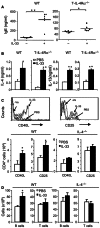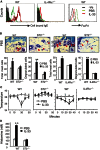Interleukin-33 amplifies IgE synthesis and triggers mast cell degranulation via interleukin-4 in naïve mice
- PMID: 22702477
- PMCID: PMC3660789
- DOI: 10.1111/j.1398-9995.2012.02859.x
Interleukin-33 amplifies IgE synthesis and triggers mast cell degranulation via interleukin-4 in naïve mice
Abstract
Background: The regulation and function of IgE in healthy individuals and in antigen-naïve animals is not well understood. IL-33 administration increases serum IgE in mice with unknown mechanism. We tested the hypothesis that IL-33 provides an antigen-independent stimulus for IgE production and mast cell degranulation.
Methods: IL-33 was administered to naïve wild-type (WT), nude and ST2(-/-) , IL-4(-/-) , IL4Rα(-/-) and T-or B-cell-specific IL-4Rα(-/-) mice. IgE and cytokines were quantified by ELISA. T- and B-lymphocyte numbers and CD40L expression were determined by flow cytometry. Anaphylaxis was measured by temperature, mast cell degranulation and histamine release.
Results: IL-33 enhanced IgE production in naïve WT, T-IL-4Rα(-/-) but not in ST2(-/-) , IL-4(-/-) , IL-4Rα(-/-) or B-cell-specific IL-4Rα(-/-) mice, demonstrating IL-33 specificity and IL-4 dependency. Moreover, IL-4 was required for IL-33-induced B-cell proliferation and T-cell CD40L expression, which promotes IgE production. IL-33-induced IL-4 production was mainly from innate cells including mast cells and eosinophils. IL-33 increased mast cell surface IgE and triggered degranulation and systemic anaphylaxis in allergen-naïve WT but not in IL-4Rα(-/-) mice.
Conclusion: IL-33 amplifies IgE synthesis and triggers anaphylaxis in naïve mice via IL-4, independent of allergen. IL-33 may play an important role in nonatopic allergy and idiopathic anaphylaxis.
© 2012 John Wiley & Sons A/S.
Figures






Similar articles
-
IgE generation and mast cell effector function in mice deficient in IL-4 and IL-13.J Immunol. 2005 Jun 15;174(12):7716-24. doi: 10.4049/jimmunol.174.12.7716. J Immunol. 2005. PMID: 15944273
-
Leaves and pseudostems extract of Curcuma longa attenuates immunoglobulin E/bovine serum albumin-stimulated bone marrow-derived cultured mast cell activation and passive cutaneous anaphylaxis in BALB/c mice.J Ethnopharmacol. 2024 Mar 1;321:117529. doi: 10.1016/j.jep.2023.117529. Epub 2023 Nov 30. J Ethnopharmacol. 2024. PMID: 38042384
-
IL-33 promotes food anaphylaxis in epicutaneously sensitized mice by targeting mast cells.J Allergy Clin Immunol. 2016 Nov;138(5):1356-1366. doi: 10.1016/j.jaci.2016.03.056. Epub 2016 Jun 2. J Allergy Clin Immunol. 2016. PMID: 27372570 Free PMC article.
-
Human mast cells in anaphylaxis: from research to diagnosis.Curr Opin Allergy Clin Immunol. 2025 Oct 1;25(5):315-321. doi: 10.1097/ACI.0000000000001092. Epub 2025 Jul 23. Curr Opin Allergy Clin Immunol. 2025. PMID: 40699257 Review.
-
[Regulation of the production of IgE in man].Allerg Immunol (Paris). 1994 Sep;26(7):238-47. Allerg Immunol (Paris). 1994. PMID: 7527216 Review. French.
Cited by
-
The role of interleukin-33 in rhinitis.Curr Allergy Asthma Rep. 2013 Apr;13(2):196-202. doi: 10.1007/s11882-013-0338-z. Curr Allergy Asthma Rep. 2013. PMID: 23381303 Free PMC article. Review.
-
Transcription Factors in the Development and Pro-Allergic Function of Mast Cells.Front Allergy. 2021 Jun 7;2:679121. doi: 10.3389/falgy.2021.679121. eCollection 2021. Front Allergy. 2021. PMID: 35387064 Free PMC article. Review.
-
Animal Models of IgE Anaphylaxis.Biology (Basel). 2023 Jun 29;12(7):931. doi: 10.3390/biology12070931. Biology (Basel). 2023. PMID: 37508362 Free PMC article. Review.
-
Interleukin 33 exacerbates antigen driven airway hyperresponsiveness, inflammation and remodeling in a mouse model of asthma.Sci Rep. 2017 Jun 26;7(1):4219. doi: 10.1038/s41598-017-03674-0. Sci Rep. 2017. PMID: 28652606 Free PMC article.
-
IL-33 Sensitizes Mast Cells to PIEZO1 Stimulation Leading to Degranulation.Allergy. 2024 Dec;79(12):3517-3520. doi: 10.1111/all.16397. Epub 2024 Nov 15. Allergy. 2024. PMID: 39545515 Free PMC article. No abstract available.
References
-
- Gould HJ, Sutton BJ. IgE in allergy and asthma today. Nat Rev Immunol. 2008;67:205–217. - PubMed
-
- McCoy KD, Harris NL, Diener P, Hatak S, Odermatt B, Hangartner L, et al. Natural IgE production in the absence of MHC Class II cognate help. Immunity. 2006;24:329–339. - PubMed
-
- Finkelman FD, Holmes J, Katona IM, Urban JF, Jr, Beckmann MP, Park LS, et al. Lymphokine control of in vivo immunoglobulin isotype selection. Annu Rev Immunol. 1990;8:303–333. - PubMed
-
- Asai K, Kitaura J, Kawakami Y, Yamagata N, Tsai M, Carbone DP, et al. Regulation of mast cell survival by IgE. Immunity. 2001;14:791–800. - PubMed
Publication types
MeSH terms
Substances
Grants and funding
LinkOut - more resources
Full Text Sources

